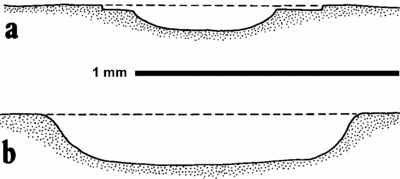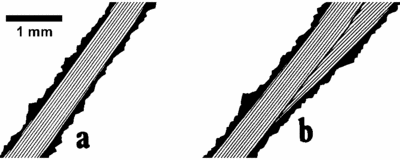Technological analyses
 Comparison of sections of grooves on ostrich eggshell: (a) engraved with a stone tool; (b) natural groove caused by micro-organisms on plant roots.
 Plan views of grooves made with stone tool on ostrich eggshell, showing the jagged margins caused by the splintering of the shell’s outermost layer: (a) single groove; (b) second line engraved over previous.
|
The above consideration of the frequency of misidentifications is perhaps one of the principal concerns in analytical work on portable palaeoart, although certainly not the only impetus for such studies. The authentication of portable objects or the markings they bear is a specialist task, much in the same way as this applies to the discrimination of doubtful rock markings. Nevertheless, it will be useful to illustrate some basic principles here. For instance, how can the analyst determine that an incised line was not made with a chert point, but with an animal claw? How does one discriminate between different types of linear markings on soft rock?
Animal claw marks are among the most common rock markings in the world, being about as common as glacial striae. To recognise individual animal marks requires considerable experience, because their morphologies differ greatly according to the species’ climbing ability and method, ‘speleo-behaviour’, mobility, relative length of extremities, shape of claws or talons and their mechanics of application, and according to the shape of the claw points. The latter, for instance, can vary according to local conditions, the specimen’s age, and so forth. Moreover, great variations can be caused by the lithology or state of the support rock (by relative hardness, moisture content, relative air humidity etc.), and most particularly by modification processes (weathering, including speleo-weathering, the deposition of speleothems, and the deforming action of some precipitates, notably certain types of carbonate deposits). It is therefore necessary to appreciate that there are no simple, ready-made rules for discriminating between animal scratch marks and other, similar rock marks. Rather, this is a process of elimination in which many factors need to be taken into account, and in which alternatives have to be discounted systematically.
The empirical basis of this discrimination process consists of two bodies of evidence: the study of markings that can securely be attributed to particular animal species (Bednarik 1993a), and the study of ‘experimental’ animal markings. The latter have involved a number of species, and in Australia especially possums (Trichosurus vulpecula). In that continent, four broad categories of animal scratch marks on rock surfaces have been distinguished (Bednarik 1991). Large accumulations of claw marks are usually much easier to identify than isolated or single marks. One of the distinguishing characteristics refers to the relative positions of multiple marks constituting a ‘set’, and the relative course of individual grooves of a multi-pronged instrument such as an animal paw. Small rock fragments may only bear one or two grooves of a set (having either exfoliated from a wall, or been marked within the sediment), which renders discrimination more difficult than on a cave wall. Other variables to be consulted include longitudinal striations frequently present in lines engraved with stone tools (animal scratches typically bear no striations); claw points are always rounded and compara-tively symmetrical, stone points are rarely so; in cross-section, a claw-caused groove is rather U-shaped, with the side walls steep, and stries parasites are never present; and morphologically, claw marks are frequently of ‘cuneiform’ appearance, i.e. with one end deeper and abrupt, and the other shallow and ‘fading’. This applies especially to short marks, and where such a mark is well preserved, the deeper and wider end can provide a fairly good impression of the shape of the claw point. An important source of relevant information is replicative experimentation with a number of potential materials (Bednarik 1987). Tool marks have been identified on the walls of about a dozen Australian limestone caves and they have been subjected to detailed ‘internal analysis’.
Another already mentioned discrimination of natural and artificial markings on portable specimens is that of grooves found on ostrich eggshell fragments. This is a material widely used in decorated form, in many regions of Africa and Asia, and in all periods beginning with the Palaeolithic (Bednarik 1993b). Again, the binocular microscope is indispensable in the analytical work. Ostrich eggshell consists of three layers, the outermost of which is less than 0.1 mm thick (Sahni et al. 1990). When the shell is engraved with a stone tool, the resulting groove is cut to well below this thin veneer, but along the edges of the groove pressure scars form a jagged, angular fringe (see images above). This is where the outermost layer of the shell splintered, and sometimes it is even possible to guess the direction of tool application from the way these scars are orientated. The grooves of root marks, by contrast, are distinctly rounded in section, and clearly attributable to a solution process rather than mechanical force. There are other features to differentiate between the two types of marking, but the described characteristics are adequate for secure discrimination if the markings have not been subjected to subsequent corrosion that obliterated such telltale features.
Clastic movement marks occur frequently on portable objects, including mobiliary art items. They are also among the most common rock marks in the world, and they are attributable mainly to glacial action, fluviatile sedimentary movement, animal borrowing, gravity and tectonic movement (e.g. through adjustment in cave systems with a sub-floor phreatic reservoir). They grade into ‘general taphonomic marks’, which include those caused by cryoturbation, solifluction and trampling. There are numerous examples on record, in most continents, of archaeologists describing taphonomic and clastic markings as anthropic engravings (e.g. Bednarik 1994d).
Technological analysis of portable palaeoart objects is, however, not limited to the question of discriminating between natural and anthropic markings. It covers a range of subjects and techniques that cannot be covered adequately in this short chapter. Much research has been lavished on the ‘internal analysis’ of engravings on portable specimens of stone, ivory, antler, bone and amber, particularly of the European Upper Palaeolithic and Mesolithic periods. Less popular, but just as important, is the determination of the materials used in the production of markings on portable objects, especially engraved grooves. In particular, the discrimination of metal and stone points used in engraving can be crucial, because metal points were entirely unavailable prior to the Bronze Age. In forms suitable for such purposes they became widely available only between 2000 and 3000 years ago in Eurasia, and later still in other parts of the world. In Australia, for instance, metal tools cannot predate the arrival of Macassans and Europeans. In the coastal zone they became widely available only about 200 years ago, and inland later still. Hence the identification of metal tool marks in Australian portable engravings (Bednarik 1997c) or rock art (Bednarik 2000) delimits their possible antiquity quite significantly.
Another form of technological analysis is almost entirely restricted to the study of portable palaeoart objects, namely the microscopic study of perforations. Most accepted beads and pendants bear artificial drill holes, and since in pre-History they have been made almost exclusively with stone points it follows that, on authentic specimens, the perforations should show distinctive diagnostic features. Indeed, these holes are generally conical or bi-conical until Neolithic times, when bow drills were introduced. If the surfaces are not too corroded, rotational striations may be visible even to the unaided eye. The tools used in this work were reamers rather than drills, and as Semenov (1964: 78) observed, these holes are often not circular. The rotating movement of the hand holding the reamer describes no full circle. The point of the reamer does not maintain its axial position, it deviates from it to follow the shape of the hole. The result is a vaguely conical but more or less distorted hole, although Palaeolithic perforations of excellent circularity are also known. True cylindrical boring or drilling only appears with the advent of the bow drill.
The bi-conical opening often observed in beads and pendants is attributable to the application of tapered stone points from both surfaces, but in many if not most cases the initial opening was achieved working only from one side. Extensive replicative work of producing disc beads identical to Pleistocene specimens, using Palaeolithic stone tool replicas, has shown that it is quite impracticable to alternatively work from both surfaces. It is difficult to meet up with the centre of the first indentation, and it is easier to ream out the new opening after the boring tool has broken through from only one side (Bednarik 1997a).
This highlights again the importance of replicative experimentation, which is an integral component of any technological analysis of portable palaeoart — irrespective of whether it is concerned with engravings, figurines or pendants. Micro-wear analysis as used in archaeology to gain insights into technological processes is closely related to much of this work. However, on the whole the potential of such analytical studies of mobiliary art remains inadequately explored, and is the preserve of very few researchers worldwide. Clearly, as in most other specialised areas of palaeoart science, we have seen little more than isolated pioneering efforts, and yet without more comprehensive research programs we will largely remain at the mercy of untestable and idiosyncratic archaeological interpretations. Analytical and replicative work of the type indicated here is absolutely crucial in enlarging our still tiny knowledge base, and in widening the horizons of palaeoart science.
R. G. Bednarik, 2002